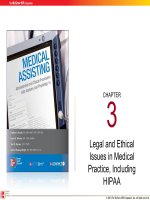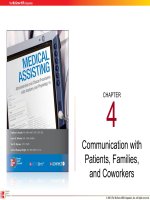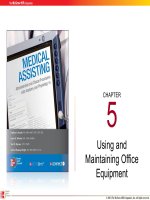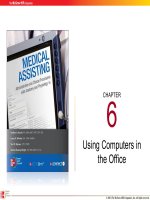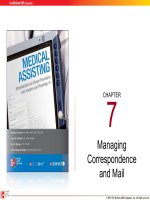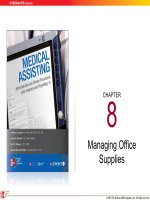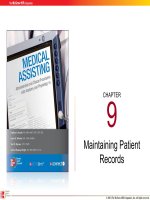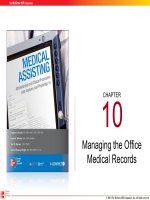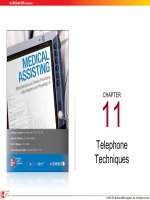Lecture Medical assisting: Administrative and clinical procedures with anatomy and physiology (4/e) – Chapter 17
Bạn đang xem bản rút gọn của tài liệu. Xem và tải ngay bản đầy đủ của tài liệu tại đây (1.27 MB, 43 trang )
CHAPTER
17
Patient Billing and
Collections
© 2011 The McGraw-Hill Companies, Inc. All rights reserved.
172
Learning Outcomes
17.1 Discuss the importance of accounts
receivable to a medical practice.
17.2 Explain how to accept and account for
payment from patients.
17.3 Prepare an invoice.
17.4 Manage a billing cycle efficiently.
© 2011 The McGraw-Hill Companies, Inc. All rights reserved.
173
Learning Outcomes (cont.)
17.5 Describe standard collection
techniques.
17.6 Explain how to perform a credit check.
17.7 Identify credit arrangements.
17.8 Recognize common collection
problems.
© 2011 The McGraw-Hill Companies, Inc. All rights reserved.
174
Introduction
• Medical assistants
take on duties that
are administrative in
nature
• Customers have
various payment
options
– Third-party payers
(insurance carriers)
– Payment plans
– Some have large
outstanding
balances
A proper understanding and administration of billing and
payment collection methods is required
© 2011 The McGraw-Hill Companies, Inc. All rights reserved.
175
Basic Accounting
• Managing
– Accounts receivable
– money owed to the
business
– Accounts payable –
money owed by the
business
• Billing and collections
convert account
receivable into readily
available income
© 2011 The McGraw-Hill Companies, Inc. All rights reserved.
176
Standard Payment Procedures
• Collect payments
from patients at
each office visit
– Brings income into
practice faster
– Saves cost of
• Preparing and
mailing bills
• Collecting on
past-due accounts
© 2011 The McGraw-Hill Companies, Inc. All rights reserved.
177
Determine Appropriate Fee
• Fee schedule is
based on
– Cost of services
– Doctor’s experience
– Charges of other doctors
in the area
– Fee allowed by
insurance policies
• Usual and
customary fees
– Average fee charged
for a service by
comparable doctors
OR
– The 90th percentile of
all fees charged by
comparable doctors
for the same
procedure
© 2011 The McGraw-Hill Companies, Inc. All rights reserved.
178
Determine Appropriate Fee (cont.)
• Relative value unit
(RVU)
– Doctor’s skill and time
– Professional liability
expenses
– Overhead costs
• RVU converted to $
amount for a service
• This methodology has
reduced the growth
rate of spending for
– Doctors’ professional
services
– Related services and
supplies
– Other Medicare B
services
© 2011 The McGraw-Hill Companies, Inc. All rights reserved.
179
Charge Slips
• Also called fee slips or transaction slips
• Numbered consecutively
• Preprinted with common services and
charges
• Uses:
– Pad of charge slips on physician’s desk
– Given to doctor with patient record at time of
appointment
– Doctor enters services provided
© 2011 The McGraw-Hill Companies, Inc. All rights reserved.
17
10
Accepting Payment
• Complete charge slip
and request payment
• Most practices accept:
–
–
–
–
For today’s visit,
the total charge is
$50. How would
you like to pay?
Cash
Check
Credit cards
Insurance
© 2011 The McGraw-Hill Companies, Inc. All rights reserved.
Accepting Payment (cont.)
17
11
• Check
– Check date and
amount
– Be sure check is
properly filled out
– Endorse it immediately
• Cash
– Count money carefully
– Record payment on
ledger
– Give patient a receipt
© 2011 The McGraw-Hill Companies, Inc. All rights reserved.
Accepting Payment (cont.)
17
12
• Debit card
– Immediate removal of
funds from bank account
– Processed like credit card
– Patient enters PIN
• Credit card
– Prompt payment and reduces
expense of mailing bills
– Costs practice a percentage of each
charge
– Check expiration date before
processing
© 2011 The McGraw-Hill Companies, Inc. All rights reserved.
Pegboard System
17
13
• Not often used
• Post payment on ledger
card
• Generates receipt at same
time
© 2011 The McGraw-Hill Companies, Inc. All rights reserved.
Determining Payment Responsibility
17
14
• Third-party liability – responsibility
of insurance company to pay
• Minors
– Parents or person with
legal custody
– Emancipated minor
• Elderly patients/patients with disabilities –proof
of guardianship
© 2011 The McGraw-Hill Companies, Inc. All rights reserved.
Determining Payment Responsibility (cont.)
17
15
© 2011 The McGraw-Hill Companies, Inc. All rights reserved.
17
16
Apply Your Knowledge
What is the difference between accounts
receivable and accounts payable?
ANSWER: Accounts receivable are monies owed to the
medical practice and accounts payable are monies owed
by the medical practice.
© 2011 The McGraw-Hill Companies, Inc. All rights reserved.
17
17
Preparing Invoices
• Preparing and mailing
– Patients who do not pay at time of appointment
– Patients who make only a partial payment
• Using codes on the invoice
– For common procedures
– Itemized list on invoice
• Using ledger cards – photocopy
and send to patient
© 2011 The McGraw-Hill Companies, Inc. All rights reserved.
17
18
Preparing Invoices (cont.)
• Generating computer invoice – print invoice for
balance due
• Using independent billing services
• Sending invoices electronically
© 2011 The McGraw-Hill Companies, Inc. All rights reserved.
17
19
Using the Superbill
• Encounter form
– Includes
• Charges for services rendered that day
• Invoice for payment or insurance copayment
• Information needed to submit insurance claim
– May be computerized
– Attach to medical record for physician to
complete at time of visit
© 2011 The McGraw-Hill Companies, Inc. All rights reserved.
Managing Billing Cycles
17
20
• Cycle billing
– Bills each patient only once
a month
– Spreads the work of billing
over the month
• Invoice groups of patients
every few days
© 2011 The McGraw-Hill Companies, Inc. All rights reserved.
17
21
Apply Your Knowledge
What is cycle billing?
ANSWER: Cycle billing is a common billing system in
which each patient is billed only once a month but
groups of patients are billed every few days—
spreads the work of billing over the month.
Excellent!
© 2011 The McGraw-Hill Companies, Inc. All rights reserved.
Standard Collection Procedures
17
22
• Collection of payment
if not paid during
standard period is
guided by
– Statute of limitations
– sets time limit on
when a collection suit
on a past-due account
can legally be filed
© 2011 The McGraw-Hill Companies, Inc. All rights reserved.
17
23
Standard Collection Procedures (cont.)
• Statute of limitations and account types
– Open-book account
• Open to charges made occasionally
• Last date of payment or charge for each illness
– Written-contract account
• Contract with patient to pay over four installations
• Regulated by Truth in Lending Act
– Single-entry account
• Account with only one charge
• Shorter time limit than open-book accounts
© 2011 The McGraw-Hill Companies, Inc. All rights reserved.
Using Collection Techniques
17
24
• Initial telephone calls or letters
– Friendly and sympathetic
– Call the patient at home
– Do not
• Call patients at work
• Leave a message on an
answering machine
© 2011 The McGraw-Hill Companies, Inc. All rights reserved.
Using Collection Techniques (cont.)
17
25
• Preparing statements
– Invoice with a courteous
reminder that payment
is due
– Send a collection letter when account is past
due
• 60 days – nice but firm
• 90 days – stronger wording
• 120 days – final letter before forwarding to a
collection agency
© 2011 The McGraw-Hill Companies, Inc. All rights reserved.

